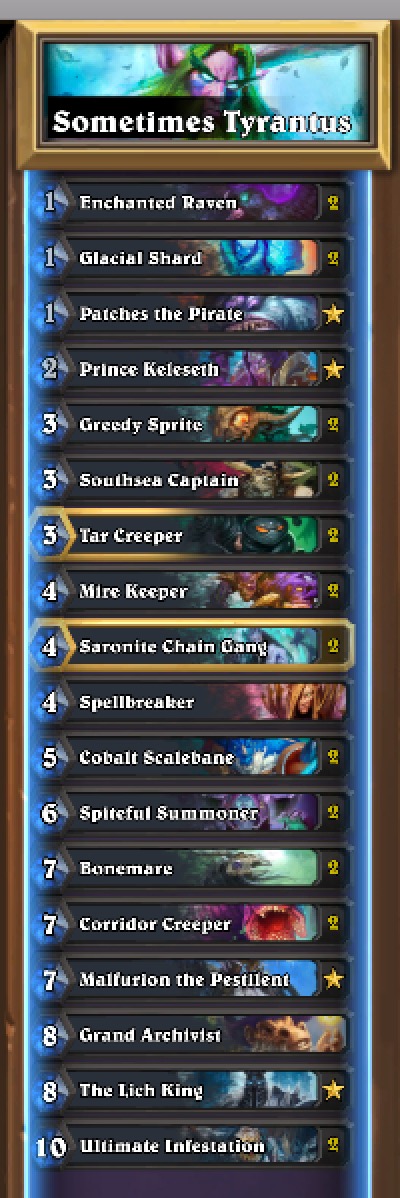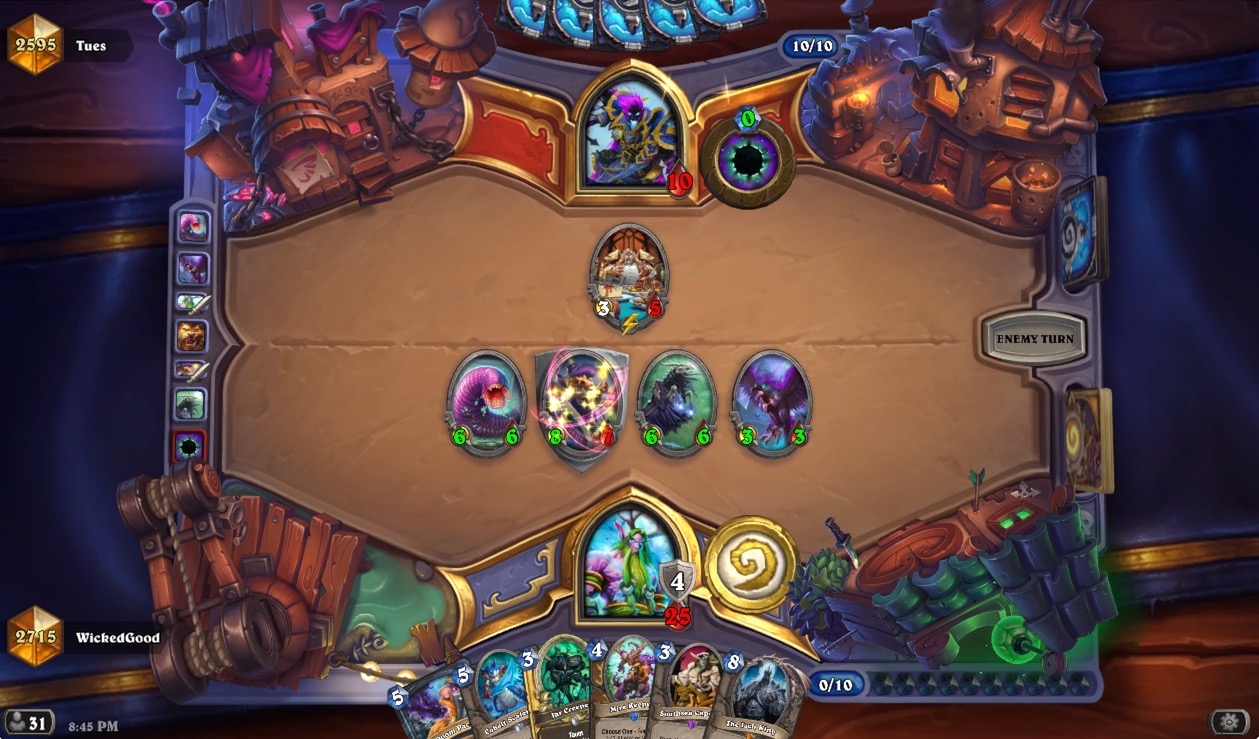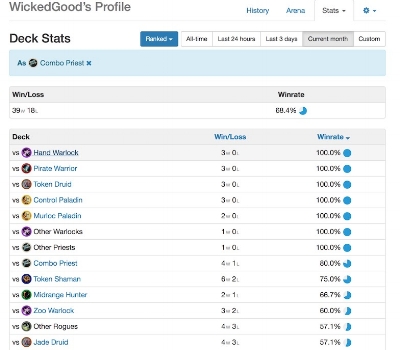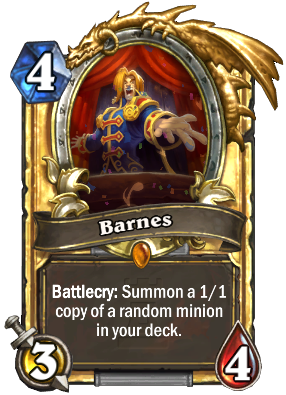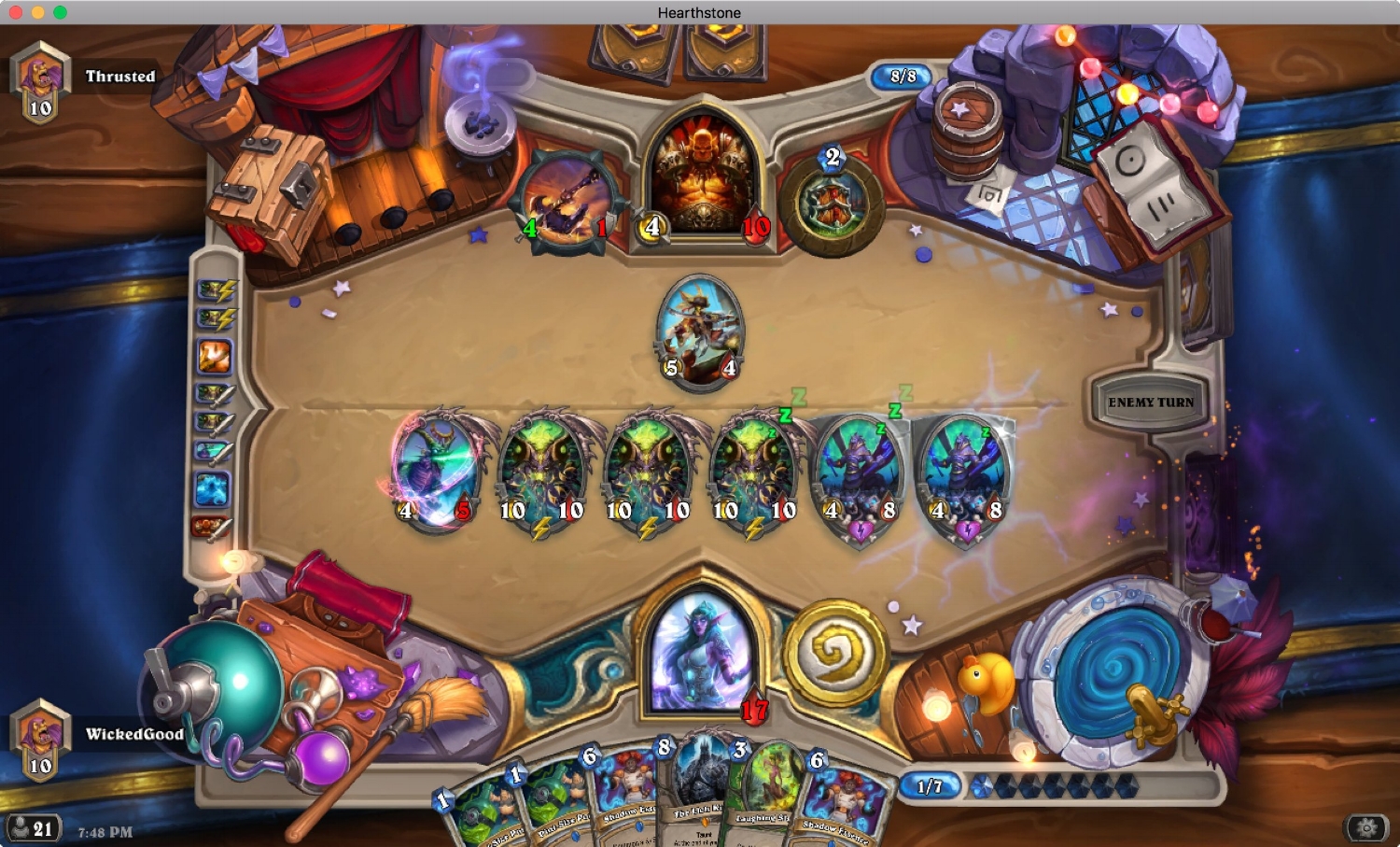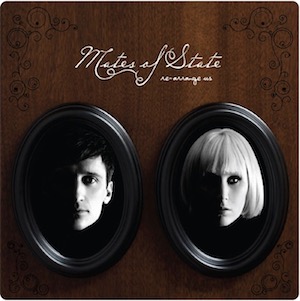Why So Spiteful, Summoner?
Because Gadgetzan Auctioneer, imma let you finish, but Spiteful Summoner has the best deals of all time.
Spiteful Summoner Druid is a tempo deck that’s easily on par with Tempo Rogue or Dragon Priest in terms of explosiveness and ability to snowball the board. It’s overlooked because it looks incredibly awkward, but in practice it can keep up with all but the most aggressive of lists and get to victory before most control decks can prepare a response. The bonus of this being new to the meta is that most opponents will mulligan either for Jade or Aggro Druid, and this list is somewhere in between, so you can usually take advantage of the element of surprise, at least for now.
While it looks really awkward having basically no removal in this deck, you often don’t need it. Being able to ramp on turns 3 and 4 means that you’re progressing into your midgame very quickly, and you can utilize your minions to execute value trades for removal until you start pressuring. In other words, you usually don’t need removal because your opponent will need to remove their minions for you. You do run one Spellbreaker (with room to expand to a second should you see significantly more control in your opposing matchups) and you can get removal from The Lich King and utilize Ultimate Infestation in a pinch to remove a roadblock. Ultimately, though, face is the place.
In general, your game plan is to get to Spiteful Summoner ASAP and then push face; while there are some whiffs at the 10 mana spot (C’thun and N’zoth are easily the worst pulls) you will just as often pull one of the Deathwings, Y’shaarj, or Tyrantus as early as turn 4 or 5, along with a 4/4 body alongside it. That’s a lot of pressure for any deck to deal with that early, especially if you can pair with Bonemare the following turn. There’s some card draw variance involved that will ruin your games; drawing both copies of Ultimate Infestation before your Summoners significantly weakens the power of this deck, but while those games happen, they don’t happen all that often, and if the days of Secret Paladin have taught us anything, it’s that running two copies of a 6-drop allows you to play it on curve more often than not.
Why Should You Listen to Me?
I’m a multiple legend player who climbed from rank 4, 5 stars to legend over the course of two days with this deck, with a 70% win rate over the course of the climb. I began with the list featured in the Vicious Syndicate Data Reaper Report from January 25th, and made a swap of Fire Fly to Glacial Shard at rank 2, 1 star; I lost two games total from that point until I hit legend.
Overall stats from the legend push.
Match history from the Glacial Shard Change
Card Choices
2x Enchanted Raven: Any tempo deck needs good 1-drops, and a 1 mana 2/2 with no downside is one of the best you can get. As an extra bonus, this can cause your opponent to incorrectly assume that you're playing Aggro Druid, so they may spend removal or go out of their way to trade it off before it could be buffed by the Mark of the Lotus or Mark of Y'shaarj they think is coming, which helps the minions you actually care about stick around.
2x Glacial Shard: Again, you need 1-drops, and this felt much more useful in all stages of the game than Fire Fly did. It’s slightly weaker to rogue since they can just dagger it down or trade off a pirate, but in general, being able to present a 2 attack minion early is good. Being able to freeze a problematic 3 health minion in the early game can help you trade it off with additional pressure from a charging Patches or your hero power the following turn, and it’s extremely important to keep pace or pull ahead in the early game to allow you the space to play your ramp minions. Once you've gotten to the late game, the freeze effect is still valuable situationally, much more so than an extra 1/2 can be, especially when you're trying to empty your hand to get Ultimate Infestation played.
1x Patches the Pirate: Because you’re in charrrrrrrge now that you’re playing this deck.
1x Prince Keleseth: You’re playing a tempo deck, and since you’re not playing cheap spells, Keleseth fits right in.
He'd get along great with the seagulls from Finding Nemo.
2x Greedy Sprite: Half of the ramp package that helps this deck pull ahead. Note that you're not going to automatically drop this on 3 if you have other 3-drops in hand; you generally want to prioritize not losing board over ramp. For instance, if you’re against a rogue and they have a Southsea Captain on board, and you can choose between this and a Tar Creeper, play the Tar Creeper first at the expense of ramp. Greedy Sprite is much more important to get on curve in control matchups, but in aggro/tempo matchups you need to preserve your board state, and the 1 health can make it a liability if you just get tunnel vision and try to ramp immediately. Remember that you’re not Jade Druid or Big Druid; you have plenty of plays you can make if you miss an early opportunity to ramp.
2x Southsea Captain: Again, you’re playing a tempo deck with Keleseth so you’re playing Patches, and if you're playing Patches, you may as well get him charging out at 2/2 instead of 1/1. Make sure you keep track if Patches is still in your deck and use it for a favorable trade if so. Once Patches is out of your deck this is basically a vanilla 3/3, so don’t be afraid to use it to just fill out available mana.
2x Tar Creeper: In aggressive matchups this is a lifesaver. Prioritize playing this against a threatening board to force your opponent (hopefully) to trade in to it and give yourself a chance to catch up.
2x Mire Keeper: The other part of your ramp package. As with Greedy Sprite, make sure that you’re not ramping at the expense of losing board if you have other plays, and if you’re not playing it on curve, consider if you really need the extra mana crystal given the texture of the rest of your hand, because the extra 2/2 may be more valuable. Also, if you’re not going to use the extra mana crystal the following turn and you have other plays (for instance, if it’s turn 4 and you have Saronite Chain Gang and Malfurion in your hand), try to sequence your plays so you’re leaving over the least amount of mana. In that case, it’s better to play Chain Gang into Mire Keeper into Malfurion than Mire Keeper into Chain Gang and Hero Power into Malfurion.
2x Saronite Chain Gang: Another anti aggro tool that gets really powerful when buffed by Keleseth. If you’re seeing a lot of control (particularly control warlock), swapping one copy out for a second Spellbreaker is reasonable.
1x Spellbreaker: Silence is really strong in this meta; Voidlords are the obvious targets, but just getting through a taunt for lethal is valuable given you run no removal aside from Ultimate Infestation.
2x Cobalt Scalebane: Our game plan against control, and particularly against priest, is to stick a giant board and make the opponent deal with it. Scalebane helps a lot by buffing a minion’s attack while ensuring something lives through Dragonfire Potion. This is obviously less effective now that Psychic Scream exists, but it still works when you can get it down early thanks to ramp. Just be careful playing this into a priest’s turn 8 with only one other minion on board so Anduin doesn’t completely wipe you out.
2x Spiteful Summoner: This is the key to the deck. Since you only run 10 cost spells, you know you’re going to get a 10-drop every time, assuming you haven’t already drawn both copies of Ultimate Infestation. It probably goes without saying, but you want to get this down on curve whenever possible, and you want to prioritize playing Summoner when you’ve already drawn one copy of Ultimate Infestation, because it becomes a vanilla 4/4 for 6 mana once you’ve drawn the second copy. Keep in mind that none of the minions you will summon have taunt, so Summoner is not going to save you in a lethal on board situation. Some of the minions don’t have great stats comparatively, but the smallest you can get is a 5/7, and on average you’re going to get something with 8 or more attack and 8 or more health, which is usually more than adequate. Even C’Thun or N’zoth, as the "bad" results, aren’t bad for 6 mana with a bonus 4/4.
Hey, buddy.
For reference, the minions you can get from Summoner are:
- Kun the Forgotten King (7/7)
- Tyrantus (12/12)
- C’Thun (6/6)
- Deathwing (12/12)
- Deathwing Dragonlord (12/12)
- Faceless Behemoth (10/10)
- N’Zoth (5/7)
- Sea Giant (8/8)
- Ultrasaur (7/14)
- Yogg-Saron (7/5)
- Y’shaarj (10/10)
2x Bonemare: You’re playing a tempo deck that will often stick a board; Bonemare makes minions bigger, so that seems good. If you get Tyrantus from a Summoner, target it with the Bonemare against control so they can’t use hard removal, but target another minion other than Tyrantus if they have a board, both to spread the damage around and to preserve its health from smaller minions trading into it.
2x Corridor Creeper: You’re playing a non-control deck in the Kobolds meta, hence Creepers are in your deck. Try to save these for reload if you have a board already against control; they get cheap quickly, but putting it down onto a sizable board just makes Dragonfire Potion that much better.
1x Malfurion the Pestilent: Since this is basically Good Cards Druid, let’s put one of the best death knights in. Usually you’re going to use the hero power to push face damage, but be aware that there are some situations where armor is appropriate. Secret mage is one matchup where you don’t really need to kill them, you just need to put down taunts so they can’t get in chip damage with minions and then out-armor their direct damage. Also, don’t just auto-pick the taunts. Look at the board and determine if poison spiders are better, because there are more situations than most players would think where spiders are the correct choice, in that they do more to protect a board state when your health total isn’t in danger.
1x Grand Archivist: This card merits discussion, since many players (myself included) have vocally cut it from Spiteful Summoner Priest. The reason Grand Archivist works in this deck is it provides you emergency healing and/or card draw two turns before you can play Ultimate Infestation naturally, and it gives you a third card you can draw to obtain those effects.
The Wizard of Odd.
Often when people look at this card in combination with UI, they look at the 5 damage targeted randomly and run in the other direction. Playing this card involves recognizing the correct situation for it. You do not blindly play this card on curve, ever. Grand Archivist is for situations where you’ve lost board and exhausted your hand, and you either need card draw or armor gain or both right now. In that specific scenario, this is what happens: 100% of the time, you get a 5/5. 100% of the time, you draw 5 cards. Most of the time, you gain 5 armor. The only variance comes in where the 5 damage goes, and there are generally two bad outcomes: If it hits the Archivist, you still have a 4/2 and a 5/5 and gain 5 armor. If it hits your face, the damage and armor cancel out and you still have a 4/7 and a 5/5. So the bad outcomes are reasonable, and you can calculate the odds of that versus the number of minions your opponent has on board plus their face, and usually the odds are in your favor.
There is a small possibility that it can pull running UIs out of your deck, but you’re more likely to draw the second UI from the first one than have that happen. Grand Archivist has won a few games for me and I wouldn’t cut it from the deck unless you don’t own any and don’t have the dust to craft one. I think running two copies with only two spells is a mistake, but one Archivist will improve your win rate and you shouldn’t cut it.
1x The Lich King: A lot of the time, he’s a big, dumb taunt. But sometimes you need a big, dumb taunt. You can generally make use of most of the cards he gives you, though. Death Grip can derail a priest’s plans. I’ve taken multiple Voidlords with Frostmourne. Death and Decay, Death Coil and Anti-Magic Shell give you additional burst. Obliterate and Doom Pact provide removal where you don’t run any. Army of the Dead is guaranteed to pull at least 3 minions. Again, this is one of the more replaceable cards in the list, but I’d put him in if you have him. If you want to play this list but are running into budget constraints, you could probably get away with an Ironbark Protector in this slot to learn the deck, but you’ll want the real Arthas if you’re expecting to climb in ranked.
2x Ultimate Infestation: Turns out, the only spell you need in the deck is the one that does literally everything.
"How did you get two Voidlords?" "Frostmourne."
Mulligans
In general, against all decks, you want a fast start paired with ramp. So that means you generally keep Enchanted Raven, Glacial Shard, Prince Keleseth, Southsea Captain, Greedy Sprite, and Mire Keeper (on the coin). If you have one ramp minion you should probably send back the others. If you have a good hand you can keep Corridor Creeper as well, but if you don’t have early game you should send it back.
Against aggro, you also want taunts to help you stabilize, so Tar Creeper is a keep. You can also keep Saronite Chain Gang on the coin if you know for sure it’s aggro (basically paladin or hunter) and you have other early game cards, otherwise send it back and look for earlier plays.
Against control, hold Spiteful Summoner. The way you win against greedy decks is by outvaluing them early, and it’s critical to get a Spiteful Summoner down as early as possible to create maximum pressure before they get access to their board clears and hard removal; even if they can clear the 10-drop, they still have a 4/4 plus whatever other minions you were able to stick to deal with, and that’s often too much for a control deck to manage all at once.
Glacial Shard is your friend against aggressive decks.
Substitutions
If you’re facing more control Warlock, taking out one Saronite Chain Gang for a second Spellbreaker is a reasonable move.
A list appeared as I was writing this guide that replaces one copy of Cobalt Scalebane with Leeroy Jenkins; I’m still in the process of testing that change but it feels like it improves some of the Control matchups.
For budget concerns, you can experiment with removing the pirate package and Keleseth with more Aggro Druid cards, like Druid of the Swarm, Dire Wolf Alpha, and Golakka Crawler. It may slow your early game down and remove the burst from charging Patches but it could still be viable.
You can also replace The Lich King with any good 8+ drop in your collection; that card in particular is valuable because of the utility of the death knight cards and the fact that it has taunt, but Ysera or Alexstrasza could be reasonable substitutions, or if you’re really strapped for dust, Ironbark Protector works in a pinch too. The same goes for Malfurion and the single Grand Archivist, but I’d highly recommend finding a way to get those two cards into the deck because they’re much harder to replace in terms of what they do for the deck.
The Corridor Creepers, Spiteful Summoners, and Ultimate Infestations are all core to the deck; if you’re cutting those, you’re playing something else.
Matchup Advice
Rogue
Tempo Rogue - Favored
You’re basically trying to do the same thing that the tempo rogue is trying to do, except that you can do it earlier than the rogue can, thanks to Greedy Sprite and Mire Keeper. You want to try to stay even with the rogue in the early turns; which 3-drop you play first is extremely important, since your goal is to make awkward trades for the rogue with your taunts and then use things like Patches and your hero power to clear their early minions off. If you can keep pace, going Spiteful Summoner into Bonemare usually cements the game for you, and you can reload with Ultimate Infestation to present more threats than they can address while also developing. You’re looking for chip damage early until you’ve sufficiently snowballed the board, and then face is the place.
Priest
Raza Priest - Slightly Favored
Your goal against Raza Priest is to apply constant pressure from turn 1, but not so much that they can reset the game with a board clear. You want to prioritize ramp early to get Spiteful Summoner down ASAP; if you can get one out ahead of their turn 6, you can make Dragonfire Potion awkward for them with anything but a Yogg-Saron pull, and get a decent amount of damage in ahead of Psychic Scream. At that point they’re reliant on having their single copy of Shadow Word Death as an answer, and if the pull happens to be Tyrantus, only Scream and Anduin will help. Absent Summoner, you want to build boards that are resistant to their clears. That means mixing in minions with high health and low health when you’re worried about Dragonfire Potion or Wild Pyromancer, attack above and below 5 when you’re worried about Anduin, etc. If you already have a board that’s scary enough for the Priest to want to clear, hold back Corridor Creeper for reload. The difference between dropping a big minion and dropping a big minion along a free 5/5 can be the difference between winning and losing. You generally want to end the turn before Anduin can come down, because the hero power makes it much easier for them to stabilize and clear your threats turn by turn, even without Raza. If they do manage to get Anduin down, don’t overlook Grand Archivist as a way to re-establish board, even once both copies of Ultimate Infestation have been played; a 4/7 is hard for them to clear and can give you a Bonemare target to push a lot of damage the next turn. Sometimes the priest will just get everything they need and win anyway, but in general, if you can maintain pressure to not allow them to safely draw cards on the early turns, you can stumble into a weak turn from their end where you can just step on the gas and not let up. Note that one thing that should work in your favor is that the priest needs to mulligan for Jade Druid since it’s easily their worst matchup, and holding their expensive cards should give them fewer tools to fend off your early pressure.
You can, in fact, beat Raza and Anduin on curve. Sometimes.
Dragon Priest - Favored
Similar to the rogue matchup, except you’re even faster than the dragon priest. Present threats and make them react, and just be sure not to build a board of minions with 3 or less health to play around Duskbreaker. You’re generally developing threats while they’re discovering cards, and you can have a Summoner and Bonemare down long before they can get theirs online, at which point you just steamroll them.
Warlock
Control/Cube Warlock - Slightly Unfavored
The game plan for control Warlock is similar to that against Raza Priest, except that you need to be able to end the game even more quickly in order to whittle them down before they can start chaining Voidlords, because you really don’t have any way to go over taunts aside from Ultimate Infestation. Make sure not to overcommit too many 3 health minions into turn 4 to play around Hellfire, and stagger your minions’ health in order to play around Defile. If you have a good hand in the mulligan it might be worth holding Spellbreaker to get past the first Voidlord; don’t silence the Lackey because that just delays the inevitable. If you see a lot of this matchup and little aggro, you can swap one of the Saronite Chain Gangs for a second Spellbreaker to help against the Voidlord parade.
Zoo - Favored
Like dragon priest and tempo rogue, you’re doing similar things only faster. Make sure to keep pace early, save Spellbreaker for Councilman or Bonemare targets, and push to Spiteful Summoner. It’s going to feel like you’re losing but you can flip the board all at once with a good Summoner pull. They’re going to have to tap to keep up, which will help you toward lethal when you hit them in the face with a 10 drop.
Paladin
Aggro/Murloc- Slightly Unfavored
The way you win this matchup is by throwing up a bunch of taunts and letting them make the trades for you. Tar Creeper and Chain Gang are MVPs here, and you can use your hero power and Patches to clean up some of the weakened minions. Take value trades where you can and wear them down slowly with chip damage. Also try to take off Divine Shields with your hero power when you have no other plays to play around Tarim and Rallying Blade. You’ll trade more than normal in this matchup, but the way you win is by preserving your board and removing theirs to deny them value from things like Tarim or Blessing of Kings. Try to play out more small threats instead of one big threat to stay even on board and play around Divine Favor.
Mage
Secret Mage - Unfavored
This is the one matchup where you’re going to be playing defense most of the way. Secret Mage doesn’t care about your taunts, and Counterspell only has Ultimate Infestation to trigger it. Try to save the coin or a spell from Lich King immediately before you want to play Ultimate Infestation so it doesn’t get get countered. Grand Archivist is also useful for getting UI out without Counterspell getting in the way. Prioritize armor to play around burn from hand once you’re below 15 health; if you’re careful, you can outheal the burn they can throw at your face and let them fatigue themselves to death.
Control/Big Spell Mage - Favored
You want to get in ahead of Frost Lich Jaina as much as possible. The good news is that they can only deal with your high health minions all at once with Dragon’s Fury and even then only with a high roll. Better, their Raven Familiars are useless while you have Ultimate Infestations left in your deck, because the only spells they can reveal from your deck cost 10 mana, so they lose the check every time. Like priest and warlock, just keep pressuring them and don’t give them a chance to clear your board completely. Hold your Spellbreaker in case they run Doomsayers, which some lists do. If you have multiple minions on board when you play Bonemare, try to not go all in on the highest health minion to play around Polymorph. If they get Jaina down, try to play fewer minions and hit them in the face with the Malfurion hero power to whittle them down without giving them opportunities to make more Water Elementals.
Hunter
Face Hunter - Slightly Unfavored
This matchup plays out similar to Paladin, except that you have to worry more about burst that can go over your taunts in the form of the hero power and Kill Command, plus they can charge out a Corridor Creeper with Tundra Rhino when you don’t expect it. Try to keep taunts up and trade off the beasts, and make sure once your health is lower than their attack on board plus 7 (2 from hero power and 5 from Kill Command) that you find a way to armor up as best you can. Malfurion is your best friend in this matchup assuming you can get to 7 mana.
Druid
I honestly didn’t see a single druid during the climb, but I would imagine that you’d play the aggro matchup similar to paladin, the mirror similar to tempo rogue, and the jade matchup similar to priest or control warlock.
Shaman and Warrior
Maybe next year.
Playing Against This Deck
The most important thing is to not be caught be surprise. If you mulligan for Jade Druid you’re going to start out behind. If you mulligan as you would for Aggro you should set yourself up better.
As Control, early board wipes, silences for Greedy Sprite to slow it down, and some sort of hard removal for the 10-drop are key; if you can survive the first few waves and get to a point where the Druid has a weak turn, you should have a chance to start setting up and advancing your win condition. Just be prepared for the big minion to drop on their 6 mana turn, and try to get as much value from your board clears as you can without exposing your life total too much. You may need help from their deck order (ramp after 10 mana, both UIs before the Summoners, etc) but you can come out on top if you can survive the initial aggression.
As Aggro or Tempo you just need to be able to go faster than the Druid can. Be prepared for taunts to come down and try to save a buff or removal for them. If you're ahead by the Druid's 6 mana turn, the Summoner itself isn’t as much of an issue for you (because the 10-drop won't have taunt) but the follow up Bonemare will be, so factor that into whether you need to try to clear the huge minion or not. Your window of opportunity is the first four turns to establish a dominant board position while they’re busy ramping. If you can do that while holding a silence for the Bonemare target you should be able to push enough damage. Also, don’t trade off the Greedy Sprite; let the Druid do that for you, because A) they always will, and B) that delays their ramping by one turn, which gives you more opportunity to develop your board.
Staggering!
Go Spite Their Face!
Spiteful Summoner Druid is a fresh take on a fairly familiar concept. The bad news is that it still feels mostly similar to decks you’ve likely been playing for a while now. The good news is that if you care mostly about winning, this beats Tempo Rogue at its own game, while being fast enough to surprise the control decks. You probably already know how to play this deck if you’ve played Tempo Rogue for any amount of time, so you should be able to get started quickly and start getting good results right away. If you’re frustrated with your available options, give this deck a try. And then be thankful that Patches is only in charrrrrrge for a few more months.
If you like this content, please consider subscribing to my weekly podcast, Off Curve, where I talk about Hearthstone while driving home on my commute. You can find it in iTunes and on Google Play. You can also follow me on Twitter and Twitch for more Hearthstone content. Thanks for reading!
Deck Import Code
AAECAZICBvIFkbwCws4CmdMCnOIC0OcCDKgFvq4CtrMCl8ECysMCm8sCyssCh84Cps4C+9MC+eYC1+sCAA==

